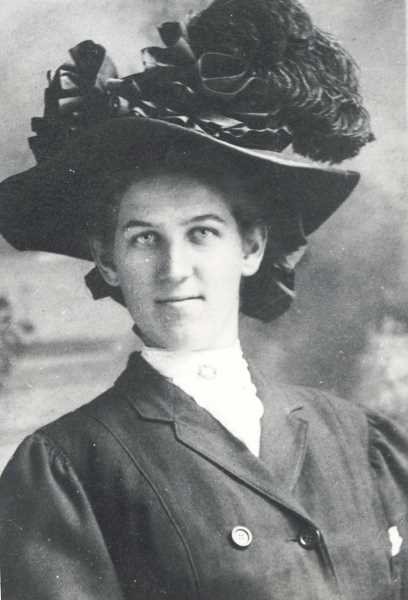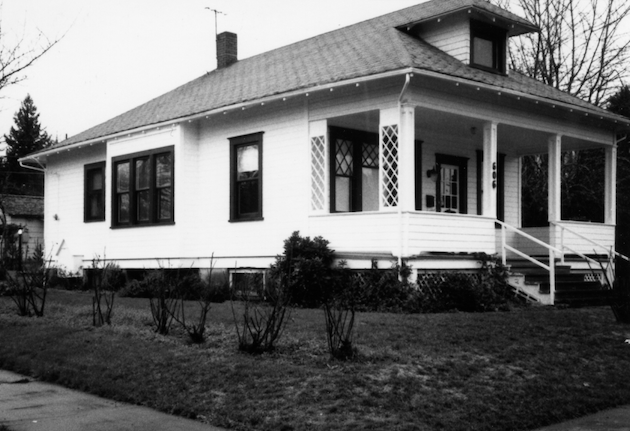Considered one of Oswego’s early pioneer farmers, Lucy Pollard–nee Felicie Marie Virginie Puylaert (1889-1974) moved from Michigan to Oregon with her mother and father, Peter and Johanna Puylaert-later changed to Poillard for ease of spelling and pronunciation when she was just three months old. Peter Pollard talked his wife into moving when he heard iron ore had been discovered “out west”. Although he had worked in foundries in Michigan, Pollard couldn’t resist the thought of the possibilities Oswego offered.

Settling first in Old Town (the area south and east of Lakewood Center for the Arts) in 1890, Pollard hired on immediately at the Oswego iron smelter. But tragedy struck, forcing him to give up the risky work of smelting iron. At the insistence of his wife, who didn’t want to become a widow raising eight children, Pollard turned to farming.
The family moved from Old Town to a 10-acre parcel of land on what is now Bergis Road across from Sacred Heart and Oswego Pioneer Cemeteries. The property ran along a portion of Stafford Road and extended from Bergis Road down to McVey Ave. Theresa Truchot remembers in her book In Their Own Words: ”Lucy found and purchased the acreage. She loved that home and the gentle land. It had a well, fertile soil. and raised good crops. At harvest time the family shined and scrubbed up the carrots, beets, and turnips; tied them into bundles; loaded them into the horse-drawn farm cart and rode through Oswego hawking their farm-fresh produce.”
A popular young woman, Lucy Pollard had many suitors, one of which was Edmond Gonty. Lucy was reluctant to marry Gonty; but after a 6-month courtship and insistence from family members, she succumbed. Lucy and Edmond married in 1919. Like Lucy’s parents, Gonty also hailed from Belgium. He came to Portland with his mother Mary, a widow, and brother Edward in 1917, setting himself up in business as a taxidermist.

But the marriage did not go well. Edward’s mother, a robust German woman, lived with the couple but was not fond of Lucy and spoke nary a word to her daughter-in-law. For two years Lucy suffered the silent treatment, often telling her mother how miserable she was. Lucy and Edmond divorced and she returned to the family farm and the land she loved, where she farmed vegetables to her heart’s content. Lucy owned a small home in Oswego which she had moved to the farm property. She lived there with her widowed father and her siblings, Henry and Anna. until her death in 1974.
Lucy’s ex-husband Ed remarried Anna Jane Bewley in September 1931 and moved to Hillsboro, giving up taxidermy for farming. Edmund Gonty passed away In October 1952. Lucy’s mother-in-law also remarried a Mr. Charles A. Groshens. She resided on SW 2nd Avenue in Portland and passed away on April 6, 1925.
Educated in the first school built in Oswego, Lucy developed a love of books. When she wasn’t farming or reading, she visited Helen Grigg’s Oswego Quilters quilting group. That group is still quilting – and has been for over 50 years. Throughout her life Lucy maintained an avid interest in the local pioneer families, their history and the history of the area. Nellie Kyle remembers: “Lucy used to attend funeral services at Oswego Pioneer Cemetery so she could visit with the old-timers.”
More about Lucy Pollard can be found in my book History Soup – Stories of Oswego’s Past.

We’re thrilled to welcome Nancy as a contributor to the Palisades Neighborhood Association’s monthly newsletter, where she’ll be serving up fascinating historical stories about Lake Oswego. Get ready to dive into the rich, colorful past of our community—History Soup style! Find out more about Nancy on her website, or purchase her books available on Amazon.
Nancy Dunis is a passionate public historian, dynamic storyteller, and published author with a flair for bringing the past to life. As the founder of History Soup Press, she’s the creative force behind the History Soup book series and The HistoriConnection blog. For over 20 years, Nancy has been sharing captivating historical nonfiction through newspaper columns, blogs, magazines, social media, newsletters, and three compelling books.
With a special focus on barrier-breaking women, infamous men, and unforgettable events, she uses a wide range of audience engagement techniques to make history accessible, exciting, and relevant.


